Fall 2024 Referendum Results Analysis
We certainly keep an eye on what passes and what fails, but the interesting trends we can capture are no less important. Sure, voters approved such-and-such percentage of facility referendums … but is that a normal amount?
Here’s your summary: This school year’s results are very normal.
Takeaway 1: The percentage of referendums voters passed increased over recent cycles and remains near record highs.
A visual really helps here. Of the 138 questions on the ballot this school year, 107 passed (77.5%). Since 1993-94 (when the state instituted revenue limits), this is the fifth highest ever – only four school years had a greater percentage pass.
Keep your eyes on that graph below, though. Something changed in 2011-12. Recall that that was the first full school year Act 10 was in place. That year really seems to create a dividing line in the data. In any given year, about 60% of referendums on the ballot pass. BUT… before 2011, the average proportion of referendums passed was almost exactly 50%. Since 2011, the average percentage of referendums passed is 73.1%.
We may need a before-and-after in this data. While interesting, pre-2011 data may not be the comparison dataset it once was.
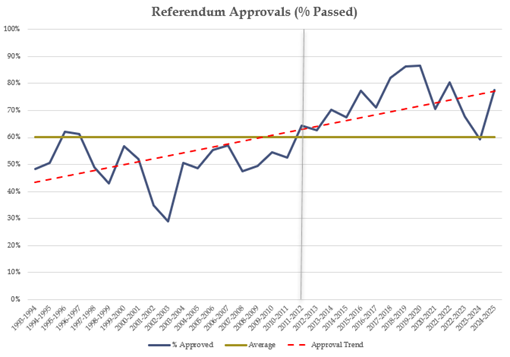
The graph below does just that – isolates data from 2011 to the present. Look how unremarkable this year was. It’s pretty darn close to the average percentage of referendums voters approve; the trend line is basically flat; and the percentage of referendums voters approved is pretty close to the average.
This cycle might catch eyes because voters approved a greater percentage than the last couple years. But zoom out a bit further, and this year is pretty standard.
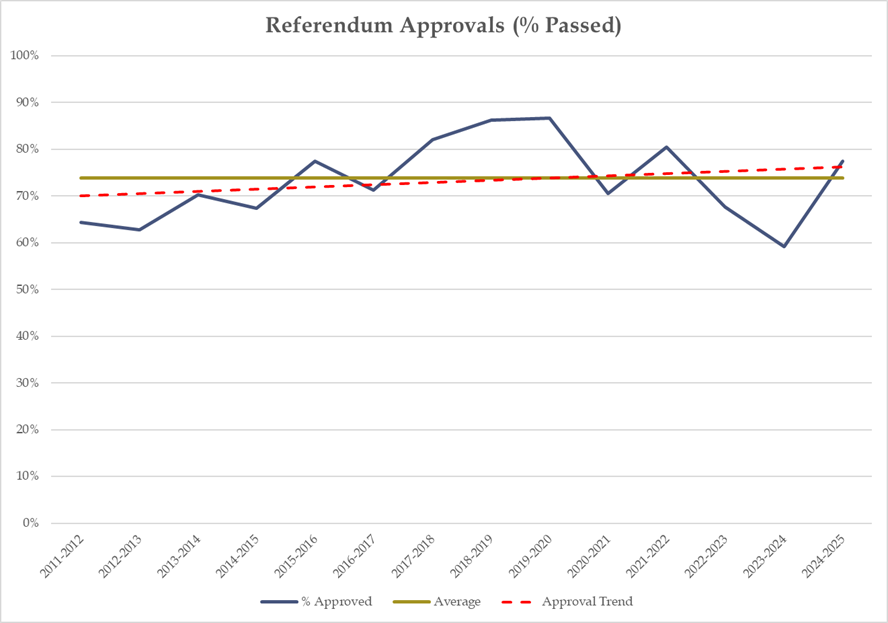
Takeaway 2: The jump in approvals was driven by voter support of capital (facility) referendums.
Once again, the graph can tell this story. At 87.9%, this was the second highest proportion of capital referendums voters approved – second only to 2019-20, when voters approved 89.3%. This is way, way above the 30-some-year average at 60.7% approvals in any given year.
At the same time, the number of capital referendums on the ballot was hardly news. In fact, the 58 facility referendums voters considered fell almost right smack dab in the middle of the dataset. In the mid-‘90s, voters often saw close to 150 capital referendums on their ballots across the state. Since 1993-94, 15 school years saw more capital referendums, and 16 school years saw fewer.
Same theme: not really all that remarkable.
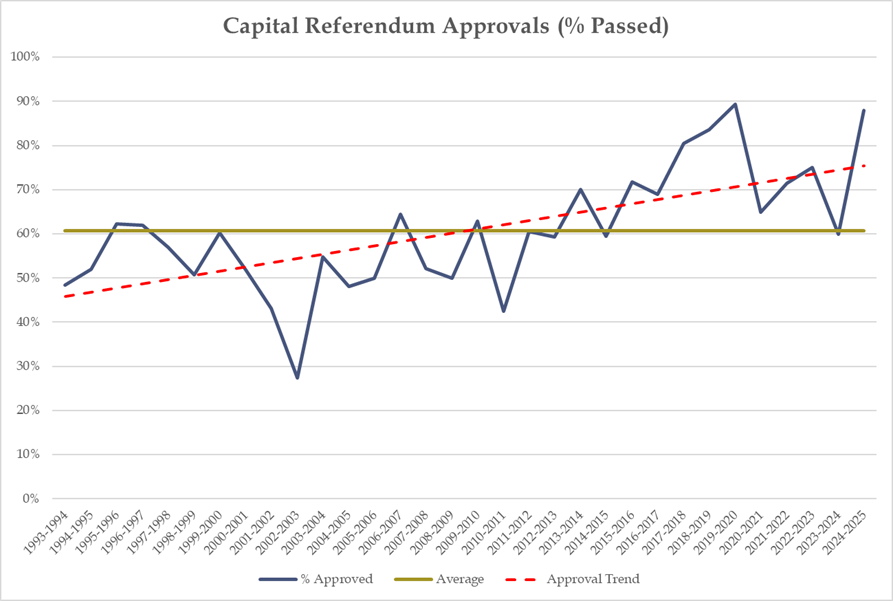
Takeaway 3: Voters’ preference for facility referendums over operational referendums hasn’t been this wide in quite some time.
This is where we can really get into the fun stuff. Bear with me as I throw four graphs at you at one time. We’ll make our way clockwise, beginning in the upper left.
We can still see a pretty strong distinction between pre- and post-2011. Before 2011, about 55% of non-recurring operational referendums passed in any given school year. Since 2011, about 77% pass in any given school year. This year, 68.3% passed. That’s pretty darn close to the overall average at 65.9% across all years. However, it’s far below where the state has been. This year is a tick above the last two years but far, far below the mid-2010s, when voters were approving 85 to 95% percent of the non-recurring referendums on their ballots.
Recurring referendums (the kind in which additional funding does not expire) are always a little strange because there just aren’t that many of them. In many years, there are barely one-third the number of recurring referendums compared to non-recurring. At the risk of sounding like a broken record, 2011 is a divider. Only about 33% of recurring referendums passed in any given year before 2011. Since then, about 69% pass in any given year. But man… those denominators. In some years, there were only four, six, eight recurring referendums – barely any (that’s why the graph in the upper right looks so choppy). And keep your eyes on that upper-right graph for a second. The percentage of recurring passed? Pretty unremarkable. This year really isn’t all that different from the past few.
Now, put these ideas together (see bottom right). Non-recurring referendums (the additional funding expires-type referendum) almost always used to beat recurring referendums (the additional funding forever type). Over the past few years, it’s been mixed. But I’ll say it again. Not only are there far fewer recurring referendums on the ballot, but the ones we test are also for far less money.
That brings us to the bottom left. In most years since 2011, the percentage of operational referendums voters approved (recurring and non-recurring alike) was higher than the percentage of capital referendums voters approved. Not so much anymore.
In four of the past six years, a higher proportion of capital than operational has passed. This year wasn’t even close. While 87.9% of capital referendums passed, “only” 70.7% of operational referendums passed. You’d have to go all the way back to the 1998-99 school year to find a gap between the two that wide.
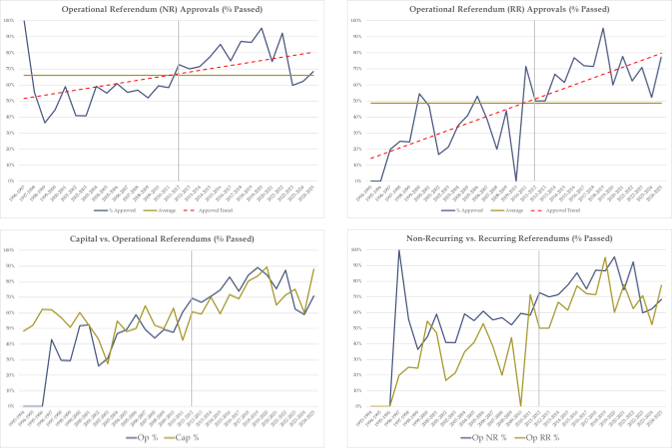
Takeaway 4: The approval bounce-back was common across locales.
Isolating results can get pretty interesting sometimes because most school districts in Wisconsin are rural, while very, very few are classified as urban. Thus, putting everyone together can hide some interesting trends because the overall numbers get washed out by rural trends.
Not so this year. And at this point, I might as well copy-paste. Across all three locales (rural, suburban, urban), the percentage of referendums passed by voters increased over the past few cycles. The latest round of approvals is well above the 30-year average but a very normal approval rate for the last 10 or so years.
Not for nothing, you can see how few urban schools there are in Wisconsin, and only a subset go to referendum in any given year. This year, there were eight questions total.
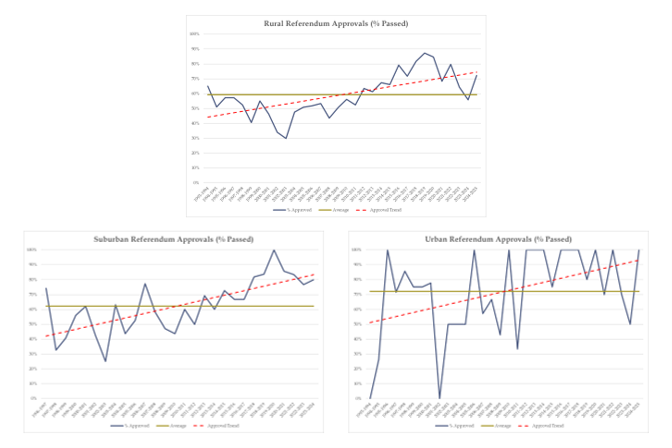
Takeaway 5: More money asked for, more money approved.
This may be the only takeaway that shows a contrast. Never has there been more money on the ballot over the past 31 years. Ever. In fact, for the first time, the state breached $4 billion (with a “b”…). This is evident in the chart below, which adjusts for inflation.
Look at this a different way. The previous record ask was in 2022-23, when schools asked for a total of $3.4 billion statewide. That’s how much voters approved this year.
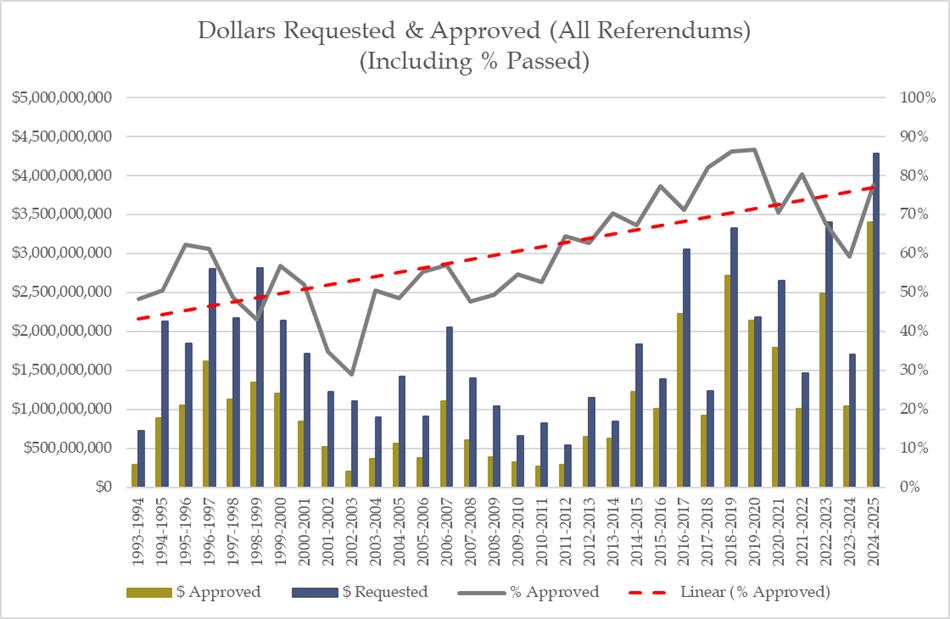
Miscellaneous takeaways:
- The correlation holds: as turnout increases, the percentage of referendums approved increases as well. The highest proportion of referendums approved by voters is in November, and November presidential elections have higher rates of referendum approval than November gubernatorial elections. It goes like this: 74% of referendums are approved in November presidential, 69% November gubernatorial, 59% April, 52% February, and 51% all other months.
- While there were many approvals, they are passing by a smaller margin. Around 2016, those that passed were seeing approval percentages around 62%. Now, those that pass are seeing an average of 58% support – a drop of 4%. While that may not seem like much, consider that nearly 800 referendums have been approved since 2016. To see that much movement across that many referendums means that referendums are being approved, sure, but they are accruing fewer yes votes.
- At the same time, referendums that lost didn’t lose by as much this cycle. Even the losses averaged about 45.5% support. The outlier here is capital referendums. Those that lost got beat up pretty handily. Operational referendums had a much narrower spread between yes-no votes.
A few research notes:
- Juda and Waunakee did something interesting: one operational question included both a recurring and non-recurring element. We counted this as two questions in our analysis even though it appeared as one because I wanted to see its specific effect on our NR and RR data. Other analyses’ denominators may, as a result, be different.
- Speaking of denominators, we do our analysis by school year (July 1 to June 30). That means that Riverdale’s August referendum is included in this analysis above.
- Cambridge University Press told me I could use referendums or referenda. I assume they would know.
The School Perceptions Blog and Resource Center features the voices of our team members. This post was written by Rob DeMeuse, Vice President of Research.